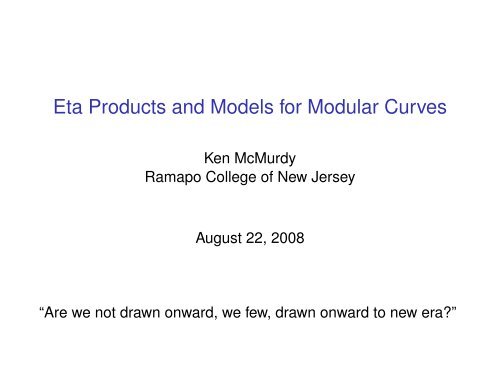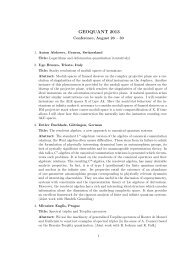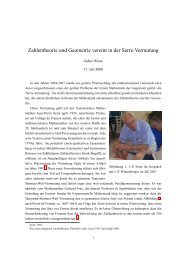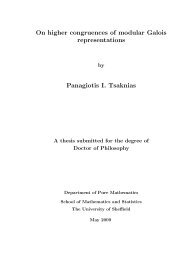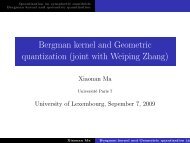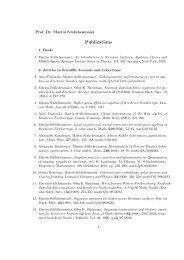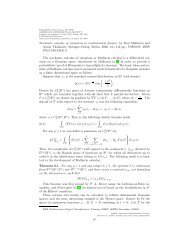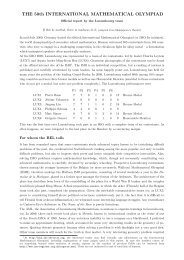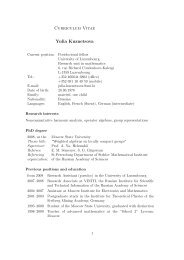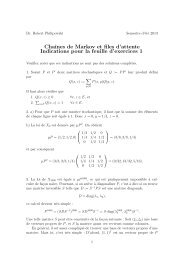Eta Products and Models for Modular Curves
Eta Products and Models for Modular Curves
Eta Products and Models for Modular Curves
You also want an ePaper? Increase the reach of your titles
YUMPU automatically turns print PDFs into web optimized ePapers that Google loves.
<strong>Eta</strong> <strong>Products</strong> <strong>and</strong> <strong>Models</strong> <strong>for</strong> <strong>Modular</strong> <strong>Curves</strong><br />
Ken McMurdy<br />
Ramapo College of New Jersey<br />
August 22, 2008<br />
“Are we not drawn onward, we few, drawn onward to new era?”
Cusps, as Families of Tate <strong>Curves</strong><br />
Definition: X 0 (N) is the projective curve whose points over C p<br />
correspond to pairs (E, C) where E is a generalized elliptic<br />
curve <strong>and</strong> C ⊆ E is a cyclic subgroup of order N which meets<br />
every component of E.
Cusps, as Families of Tate <strong>Curves</strong><br />
Definition: X 0 (N) is the projective curve whose points over C p<br />
correspond to pairs (E, C) where E is a generalized elliptic<br />
curve <strong>and</strong> C ⊆ E is a cyclic subgroup of order N which meets<br />
every component of E.<br />
Every cusp is surrounded by a family of Tate curves (with level<br />
structure) which degenerate into the corresponding Néron<br />
n-gon.
Cusps, as Families of Tate <strong>Curves</strong><br />
Definition: X 0 (N) is the projective curve whose points over C p<br />
correspond to pairs (E, C) where E is a generalized elliptic<br />
curve <strong>and</strong> C ⊆ E is a cyclic subgroup of order N which meets<br />
every component of E.<br />
Every cusp is surrounded by a family of Tate curves (with level<br />
structure) which degenerate into the corresponding Néron<br />
n-gon.<br />
Definition: For d|N, the canonical families of width d on X 0 (N)<br />
are given by (C ∗ p/q d , 〈ζq〉), where ζ is any primitive r th root of<br />
unity such that lcm(r, d) = N.
Cusps, as Families of Tate <strong>Curves</strong><br />
Definition: X 0 (N) is the projective curve whose points over C p<br />
correspond to pairs (E, C) where E is a generalized elliptic<br />
curve <strong>and</strong> C ⊆ E is a cyclic subgroup of order N which meets<br />
every component of E.<br />
Every cusp is surrounded by a family of Tate curves (with level<br />
structure) which degenerate into the corresponding Néron<br />
n-gon.<br />
Definition: For d|N, the canonical families of width d on X 0 (N)<br />
are given by (C ∗ p/q d , 〈ζq〉), where ζ is any primitive r th root of<br />
unity such that lcm(r, d) = N.<br />
Each family defines a rigid map from the disk |q| < ɛ into X 0 (N)<br />
which takes q = 0 to one of the cusps (z → z gcd(d,N/d) followed<br />
by an injection). Note: it is easy to check when two families<br />
represent the same cusp (there are φ(gcd(d, N/d)) different<br />
ones of width d).
Lemma: (C ∗ p/q d , 〈ζq〉) ∼ (C ∗ p/q d 1 , 〈ζq 1〉) if <strong>and</strong> only if<br />
q gcd(d,N/d) = q gcd(d,N/d)<br />
1<br />
.
Lemma: (C ∗ p/q d , 〈ζq〉) ∼ (C ∗ p/q d 1 , 〈ζq 1〉) if <strong>and</strong> only if<br />
q gcd(d,N/d) = q gcd(d,N/d)<br />
1<br />
.<br />
Pf/ Let λ be a primitive N th root of unity. So ζ = λ jN/r <strong>for</strong> some j with<br />
(j, r) = 1. Then the two elliptic curves are isomorphic if <strong>and</strong> only if<br />
q 1 = (λ) kN/d q <strong>for</strong> some k.
Lemma: (C ∗ p/q d , 〈ζq〉) ∼ (C ∗ p/q d 1 , 〈ζq 1〉) if <strong>and</strong> only if<br />
q gcd(d,N/d) = q gcd(d,N/d)<br />
1<br />
.<br />
Pf/ Let λ be a primitive N th root of unity. So ζ = λ jN/r <strong>for</strong> some j with<br />
(j, r) = 1. Then the two elliptic curves are isomorphic if <strong>and</strong> only if<br />
q 1 = (λ) kN/d q <strong>for</strong> some k.<br />
First suppose 〈λ jN/r q〉 = 〈λ jN/r λ kN/d q〉. Then<br />
jN/r = (jN/r + kN/d)(1 + ld) + mN<br />
0 = kN/d + ldjN/r + ldkN/d + mN.<br />
Thus, we see that d ∣ ∣ (kN/d). So<br />
d<br />
gcd(d,N/d)<br />
∣ k.<br />
There<strong>for</strong>e q gcd(d,N/d)<br />
1<br />
= λ kN gcd(d,N/d)/d q d = q d .<br />
The other direction is similar.
The Tate Curve C ∗ p/q d with Some of its N-torsion<br />
C<br />
p<br />
!.<br />
3 !<br />
q. .<br />
2<br />
. q<br />
.<br />
2<br />
. q d<br />
. q 3<br />
!<br />
.<br />
1
Definition of <strong>Modular</strong> Forms<br />
Definition: A modular <strong>for</strong>m of weight k <strong>for</strong> Γ 0 (N) is a function<br />
which takes pairs (E, C) as input, <strong>and</strong> outputs a section of Ω ⊗k<br />
E .<br />
(sufficiently well-behaved, of course)
Definition of <strong>Modular</strong> Forms<br />
Definition: A modular <strong>for</strong>m of weight k <strong>for</strong> Γ 0 (N) is a function<br />
which takes pairs (E, C) as input, <strong>and</strong> outputs a section of Ω ⊗k<br />
E .<br />
(sufficiently well-behaved, of course)<br />
Definition: Suppose f is a weight k modular <strong>for</strong>m <strong>for</strong> Γ 0 (N).<br />
The q-expansion of f associated to the canonical family<br />
(C ∗ /q d , 〈ζq〉) is the unique f (q) such that<br />
( ) ⊗k<br />
f (C ∗ p/q d , 〈ζq〉) = f (q) dz<br />
z .
Definition of <strong>Modular</strong> Forms<br />
Definition: A modular <strong>for</strong>m of weight k <strong>for</strong> Γ 0 (N) is a function<br />
which takes pairs (E, C) as input, <strong>and</strong> outputs a section of Ω ⊗k<br />
E .<br />
(sufficiently well-behaved, of course)<br />
Definition: Suppose f is a weight k modular <strong>for</strong>m <strong>for</strong> Γ 0 (N).<br />
The q-expansion of f associated to the canonical family<br />
(C ∗ /q d , 〈ζq〉) is the unique f (q) such that<br />
( ) ⊗k<br />
f (C ∗ p/q d , 〈ζq〉) = f (q) dz<br />
z .<br />
So at this point, we’ve defined q-expansions associated to<br />
families of Tate curves, based on the moduli-theoretic definition<br />
of modular <strong>for</strong>ms. Why?
Pullbacks by Level-Lowering Maps<br />
Suppose that Ml ∣ ∣N. It is well-known that we have maps,<br />
π l : X 0 (N) → X 0 (M), defined by<br />
π l (E, C) = (E/C[l], C[Ml]/C[l]).<br />
We can also define the π l pullback of a modular <strong>for</strong>m f <strong>for</strong> Γ 0 (M).
Pullbacks by Level-Lowering Maps<br />
Suppose that Ml ∣ ∣N. It is well-known that we have maps,<br />
π l : X 0 (N) → X 0 (M), defined by<br />
π l (E, C) = (E/C[l], C[Ml]/C[l]).<br />
We can also define the π l pullback of a modular <strong>for</strong>m f <strong>for</strong> Γ 0 (M).<br />
Definition: Let f be a weight k modular <strong>for</strong>m <strong>for</strong> Γ 0 (M), with Ml ∣ ∣N as<br />
above. Then we define<br />
(π ∗ l f )(E, C) = ι ∗ (f (E/C[l], C[Ml]/C[l])),<br />
where ι : E → E/C[l] is the canonical isogeny <strong>and</strong><br />
ι ∗ : Ω ⊗k<br />
E/C[l] → Ω⊗k E .
Pullbacks by Level-Lowering Maps<br />
Suppose that Ml ∣ ∣N. It is well-known that we have maps,<br />
π l : X 0 (N) → X 0 (M), defined by<br />
π l (E, C) = (E/C[l], C[Ml]/C[l]).<br />
We can also define the π l pullback of a modular <strong>for</strong>m f <strong>for</strong> Γ 0 (M).<br />
Definition: Let f be a weight k modular <strong>for</strong>m <strong>for</strong> Γ 0 (M), with Ml ∣ ∣N as<br />
above. Then we define<br />
(π ∗ l f )(E, C) = ι ∗ (f (E/C[l], C[Ml]/C[l])),<br />
where ι : E → E/C[l] is the canonical isogeny <strong>and</strong><br />
ι ∗ : Ω ⊗k<br />
E/C[l] → Ω⊗k E .<br />
Big Idea: We can use Tate curve calculations to compute the<br />
q-expansions of πl ∗ f in terms of the q-expansions of f .
Theorem 1: Suppose r, d, M, <strong>and</strong> l are positive divisors of N, such<br />
that Ml ∣ ∣ N (so πl : X 0 (N) → X 0 (M)) <strong>and</strong> lcm(d, r) = N. Suppose ζ is<br />
a primitive r th root of unity. Suppose f is any weight k modular <strong>for</strong>m<br />
<strong>for</strong> Γ 0 (M).
Theorem 1: Suppose r, d, M, <strong>and</strong> l are positive divisors of N, such<br />
that Ml ∣ ∣ N (so πl : X 0 (N) → X 0 (M)) <strong>and</strong> lcm(d, r) = N. Suppose ζ is<br />
a primitive r th root of unity. Suppose f is any weight k modular <strong>for</strong>m<br />
<strong>for</strong> Γ 0 (M).<br />
Let g = gcd(d, N/l), <strong>and</strong> find a, b ∈ Z s.t. ad + b(N/l) = g.
Theorem 1: Suppose r, d, M, <strong>and</strong> l are positive divisors of N, such<br />
that Ml ∣ ∣ N (so πl : X 0 (N) → X 0 (M)) <strong>and</strong> lcm(d, r) = N. Suppose ζ is<br />
a primitive r th root of unity. Suppose f is any weight k modular <strong>for</strong>m<br />
<strong>for</strong> Γ 0 (M).<br />
Let g = gcd(d, N/l), <strong>and</strong> find a, b ∈ Z s.t. ad + b(N/l) = g.<br />
If<br />
then<br />
f (C ∗ p/(ζ bNg/d q lg2 /d ), 〈(ζq) lg/d 〉[M]) = f (q) ( )<br />
dz ⊗k<br />
z ,<br />
π ∗ l f (C ∗ p/q d , 〈ζq〉) = f (q)<br />
(<br />
lg<br />
d<br />
) k ( dz<br />
) ⊗k<br />
z .
Theorem 1: Suppose r, d, M, <strong>and</strong> l are positive divisors of N, such<br />
that Ml ∣ ∣ N (so πl : X 0 (N) → X 0 (M)) <strong>and</strong> lcm(d, r) = N. Suppose ζ is<br />
a primitive r th root of unity. Suppose f is any weight k modular <strong>for</strong>m<br />
<strong>for</strong> Γ 0 (M).<br />
Let g = gcd(d, N/l), <strong>and</strong> find a, b ∈ Z s.t. ad + b(N/l) = g.<br />
If<br />
then<br />
f (C ∗ p/(ζ bNg/d q lg2 /d ), 〈(ζq) lg/d 〉[M]) = f (q) ( )<br />
dz ⊗k<br />
z ,<br />
π ∗ l f (C ∗ p/q d , 〈ζq〉) = f (q)<br />
(<br />
lg<br />
d<br />
) k ( dz<br />
) ⊗k<br />
z .<br />
pf/ We want to compute π ∗ l f on (C∗ p/q d , 〈ζq〉) using the definition of<br />
π ∗ l , <strong>and</strong> in this case E = C∗ p/q d <strong>and</strong> C = 〈ζq〉. So first we apply<br />
ι : E → E/C[l] to get C ∗ p/〈q d , (ζq) N/l 〉. Now use<br />
C ∗ p/〈q d , (ζq) N/l 〉 ∼= −→ C ∗ p/(ζ bNg/d q lg2 /d )<br />
z ↦→ z lg/d
Although we will only use the theorem to pull back <strong>for</strong>ms of<br />
level 1 (in particular ∆), the theorem does tell us explicitly how<br />
to obtain the q-expansions of πl ∗ f at any cusp, given the<br />
q-expansions at the image cusp. (It’s just a substitution, since q<br />
is just a number here!)
Although we will only use the theorem to pull back <strong>for</strong>ms of<br />
level 1 (in particular ∆), the theorem does tell us explicitly how<br />
to obtain the q-expansions of πl ∗ f at any cusp, given the<br />
q-expansions at the image cusp. (It’s just a substitution, since q<br />
is just a number here!)<br />
Corollary 1.1: Suppose f is a <strong>for</strong>m <strong>for</strong> Γ 0 (1) with q-expansion<br />
f (q). Then the expansion at (C ∗ p/q d , 〈ζq〉) of πl ∗ f is given by<br />
f (ζ bNg/d q lg2 /d )<br />
(<br />
lg<br />
d<br />
) k<br />
.
Part II<br />
<strong>Eta</strong> <strong>Products</strong>
Ligozat’s Criteria<br />
Definition: Let ∆ be the usual weight 12 level 1 cusp <strong>for</strong>m, with<br />
q-expansion ∆(q). Let η(q) = (∆(q)) 1/24 . So<br />
∏<br />
∞<br />
η(q) = q 1/24 (1 − q n ).<br />
n=1<br />
An eta product is an expression of the <strong>for</strong>m ∏ l∣<br />
∣ N<br />
(η(q l )) r l.
Ligozat’s Criteria<br />
Definition: Let ∆ be the usual weight 12 level 1 cusp <strong>for</strong>m, with<br />
q-expansion ∆(q). Let η(q) = (∆(q)) 1/24 . So<br />
∏<br />
∞<br />
η(q) = q 1/24 (1 − q n ).<br />
n=1<br />
An eta product is an expression of the <strong>for</strong>m ∏ l∣<br />
∣ N<br />
(η(q l )) r l.<br />
Theorem 2: (Ligozat) An eta product is a weight 0 modular<br />
<strong>for</strong>m, i.e. a modular function, on X 0 (N), if <strong>and</strong> only if<br />
(i) ∑ r d = 0<br />
(ii) ∑ d · r d ≡ 0 (mod 24)<br />
(iii) ∑ N<br />
d · r d ≡ 0 (mod 24)<br />
(iv) ∏ (<br />
N<br />
d<br />
) rd<br />
∈ Q 2 .
q-expansions of ∆ pullbacks<br />
Theorem 3: For any l ∣ ∣ N, ∆(q l ) is the q-expansion at infinity of<br />
a weight 12 modular <strong>for</strong>m <strong>for</strong> Γ 0 (N). Its q-expansion associated<br />
to the family, (C ∗ p/q d , 〈ζq〉) is given by<br />
∆(ζ bNg/d q lg2 /d ) ( g<br />
d<br />
) 12 .
q-expansions of ∆ pullbacks<br />
Theorem 3: For any l ∣ ∣ N, ∆(q l ) is the q-expansion at infinity of<br />
a weight 12 modular <strong>for</strong>m <strong>for</strong> Γ 0 (N). Its q-expansion associated<br />
to the family, (C ∗ p/q d , 〈ζq〉) is given by<br />
∆(ζ bNg/d q lg2 /d ) ( g<br />
d<br />
) 12 .<br />
pf/ This is a direct application of Corollary 1.1. The <strong>for</strong>m in<br />
question is actually l −12 πl ∗ (∆). So from the corollary, its<br />
expansion is<br />
( ) 12<br />
l −12 ∆(ζ bNg/d q lg2 /d ) lg<br />
d .
Corollary 3.1: The leading term of the q-expansion of any<br />
delta product (associated to a fixed family) is given by<br />
∏<br />
l|N<br />
(<br />
ζ bNg/d q lg2 /d ) r l ( g<br />
d<br />
) 12rl<br />
.
Corollary 3.1: The leading term of the q-expansion of any<br />
delta product (associated to a fixed family) is given by<br />
∏<br />
l|N<br />
(<br />
ζ bNg/d q lg2 /d ) r l ( g<br />
d<br />
) 12rl<br />
.<br />
In particular, the ord at the corresponding cusp of the<br />
corresponding eta product is<br />
∑<br />
1<br />
l·r l<br />
24 gcd(d,N/d) d (gcd(d, N/l))2 .<br />
l|N
Corollary 3.1: The leading term of the q-expansion of any<br />
delta product (associated to a fixed family) is given by<br />
∏<br />
l|N<br />
(<br />
ζ bNg/d q lg2 /d ) r l ( g<br />
d<br />
) 12rl<br />
.<br />
In particular, the ord at the corresponding cusp of the<br />
corresponding eta product is<br />
∑<br />
1<br />
l·r l<br />
24 gcd(d,N/d) d (gcd(d, N/l))2 .<br />
l|N<br />
Moreover, when the ord is 0 at a particular cusp, the value of<br />
the corresponding delta product is given (up to an r th root of<br />
unity) by<br />
∏<br />
( 1 d gcd(d, N/l))12r l<br />
.<br />
l|N
<strong>Eta</strong> products on X 0 (18)
<strong>Eta</strong> products on X 0 (18)<br />
Applying the corollary about ords, we find:<br />
⎡<br />
⎤ ⎡ ⎤ ⎡<br />
⎤<br />
1 2 3 6 9 18 r 1 ord(d = 1)<br />
2 1 6 3 18 9<br />
r 2<br />
ord(d = 2)<br />
1 2 3 6 1 2<br />
⎢ 2 1 6 3 2 1<br />
·<br />
r 3<br />
⎥ ⎢ r 6<br />
=<br />
ord(d = 3)<br />
⎥ ⎢ ord(d = 6)<br />
⎥<br />
⎣ 9 18 3 6 1 2 ⎦ ⎣ r 9<br />
⎦ ⎣ ord(d = 9) ⎦<br />
18 9 6 3 2 1 r 18 ord(d = 18)<br />
Note: There are two cusps with d = 3 <strong>and</strong> two with d = 6.
<strong>Eta</strong> products on X 0 (18)<br />
Applying the corollary about ords, we find:<br />
⎡<br />
⎤ ⎡ ⎤ ⎡<br />
⎤<br />
1 2 3 6 9 18 r 1 ord(d = 1)<br />
2 1 6 3 18 9<br />
r 2<br />
ord(d = 2)<br />
1 2 3 6 1 2<br />
⎢ 2 1 6 3 2 1<br />
·<br />
r 3<br />
⎥ ⎢ r 6<br />
=<br />
ord(d = 3)<br />
⎥ ⎢ ord(d = 6)<br />
⎥<br />
⎣ 9 18 3 6 1 2 ⎦ ⎣ r 9<br />
⎦ ⎣ ord(d = 9) ⎦<br />
18 9 6 3 2 1 r 18 ord(d = 18)<br />
Note: There are two cusps with d = 3 <strong>and</strong> two with d = 6.<br />
Let f = η2 2 η 9<br />
η 1 η 2 18<br />
.<br />
By Ligozat, it is a legitimate function, <strong>and</strong> by above it has divisor<br />
(1/2) − (∞). Hence it is a parameter on this genus 0 curve.
Moreover, the values of f 24 at the d = 18, 6, 3, <strong>and</strong> 2 cusps are<br />
3 24 , 3 12 , 3 12 , <strong>and</strong> 1 (respectively, up to a root of unity). These<br />
values can be easily verified (in this case) by choosing eta<br />
products which vanish at the other cusps, <strong>and</strong> then comparing<br />
with f .
Moreover, the values of f 24 at the d = 18, 6, 3, <strong>and</strong> 2 cusps are<br />
3 24 , 3 12 , 3 12 , <strong>and</strong> 1 (respectively, up to a root of unity). These<br />
values can be easily verified (in this case) by choosing eta<br />
products which vanish at the other cusps, <strong>and</strong> then comparing<br />
with f .<br />
x = η2 1 η 6η 9<br />
η 2 η 3 η 2 18<br />
(x) = (0) − (∞) x = f − 3
Moreover, the values of f 24 at the d = 18, 6, 3, <strong>and</strong> 2 cusps are<br />
3 24 , 3 12 , 3 12 , <strong>and</strong> 1 (respectively, up to a root of unity). These<br />
values can be easily verified (in this case) by choosing eta<br />
products which vanish at the other cusps, <strong>and</strong> then comparing<br />
with f .<br />
x = η2 1 η 6η 9<br />
η 2 η 3 η 2 18<br />
(x) = (0) − (∞) x = f − 3<br />
y = η 2η 6 3<br />
η 2 1 η2 6 η3 18<br />
(y) = c 6,1 + c 6,2 − 2(∞) y = f 2 + 3
Moreover, the values of f 24 at the d = 18, 6, 3, <strong>and</strong> 2 cusps are<br />
3 24 , 3 12 , 3 12 , <strong>and</strong> 1 (respectively, up to a root of unity). These<br />
values can be easily verified (in this case) by choosing eta<br />
products which vanish at the other cusps, <strong>and</strong> then comparing<br />
with f .<br />
x = η2 1 η 6η 9<br />
η 2 η 3 η 2 18<br />
(x) = (0) − (∞) x = f − 3<br />
y = η 2η 6 3<br />
η 2 1 η2 6 η3 18<br />
(y) = c 6,1 + c 6,2 − 2(∞) y = f 2 + 3<br />
z = η 1η 8 6 η3 9<br />
η 2 2 η4 3 η6 18<br />
(z) = c 3,1 + c 3,2 − 2(∞) z = f 2 − 3f + 3
Moreover, the values of f 24 at the d = 18, 6, 3, <strong>and</strong> 2 cusps are<br />
3 24 , 3 12 , 3 12 , <strong>and</strong> 1 (respectively, up to a root of unity). These<br />
values can be easily verified (in this case) by choosing eta<br />
products which vanish at the other cusps, <strong>and</strong> then comparing<br />
with f .<br />
x = η2 1 η 6η 9<br />
η 2 η 3 η 2 18<br />
(x) = (0) − (∞) x = f − 3<br />
y = η 2η 6 3<br />
η 2 1 η2 6 η3 18<br />
(y) = c 6,1 + c 6,2 − 2(∞) y = f 2 + 3<br />
z = η 1η 8 6 η3 9<br />
η 2 2 η4 3 η6 18<br />
(z) = c 3,1 + c 3,2 − 2(∞) z = f 2 − 3f + 3<br />
w = η 6η 3 9<br />
η 3 η 3 18<br />
(w) = (1/9) − (∞) w = f − 1
What if there aren’t enough eta products?
What if there aren’t enough eta products?<br />
Answer: There are. Philosophically, Ligozat works in different<br />
weights, <strong>and</strong> we can apply the θ operator. Weight 0 to weight 2<br />
(functions to differentials) is especially straight<strong>for</strong>ward.
What if there aren’t enough eta products?<br />
Answer: There are. Philosophically, Ligozat works in different<br />
weights, <strong>and</strong> we can apply the θ operator. Weight 0 to weight 2<br />
(functions to differentials) is especially straight<strong>for</strong>ward.<br />
Theorem 4: (Shimura) Let f be a <strong>for</strong>m of even weight k. Let<br />
ν = f (z)(dz) k/2 . Then<br />
(∑ )<br />
Div(f ) = Div(ν) + (k/2) · (1 − e<br />
−1<br />
i<br />
)P i + cusps ,<br />
where {P i } are the elliptic points of order e i .
A Nice Example Involving X 0 (11)<br />
Doing the usual thing, we find that t = η1 12/η12<br />
11<br />
is a legitimate<br />
function with divisor 5(0) − 5(∞). We also get a weight two<br />
cusp <strong>for</strong>m by taking (η 1 η 11 ) 2 . Using the preceding theorem, its<br />
divisor (as a <strong>for</strong>m) is (0) + (∞).
A Nice Example Involving X 0 (11)<br />
Doing the usual thing, we find that t = η1 12/η12<br />
11<br />
is a legitimate<br />
function with divisor 5(0) − 5(∞). We also get a weight two<br />
cusp <strong>for</strong>m by taking (η 1 η 11 ) 2 . Using the preceding theorem, its<br />
divisor (as a <strong>for</strong>m) is (0) + (∞).<br />
There aren’t any elliptic points. So the function,<br />
x :=<br />
dt/t<br />
(η 1 η 11 ) 2 ,<br />
has degree 2, with a simple pole at each cusp. This implies that<br />
x is a parameter on X 0 (11) + := X 0 (11)/w 11 . By comparing<br />
q-expansions, we find:<br />
t 2 + 1 5 5 (x 5 +170x 4 +9345x 3 +167320x 2 −7903458)t +11 6 = 0.
Remark:<br />
This reduces mod 11 to<br />
t 2 + (x − 2) 2 (x + 3) 3 t = 0.<br />
It’s the blow-down of the Deligne-Rapoport model!!
Remark:<br />
This reduces mod 11 to<br />
t 2 + (x − 2) 2 (x + 3) 3 t = 0.<br />
It’s the blow-down of the Deligne-Rapoport model!!<br />
By letting<br />
y = 2 · 55 t + (x 5 + 170x 4 + 9345x 3 + 167320x 2 − 7903458)<br />
(x + 47)(x 2 + 89x + 1424)<br />
we arrive at the “nicer” model:<br />
y 2 = (x − 8)(x 3 + 76x 2 − 8x + 188).
Remark:<br />
This reduces mod 11 to<br />
t 2 + (x − 2) 2 (x + 3) 3 t = 0.<br />
It’s the blow-down of the Deligne-Rapoport model!!<br />
By letting<br />
y = 2 · 55 t + (x 5 + 170x 4 + 9345x 3 + 167320x 2 − 7903458)<br />
(x + 47)(x 2 + 89x + 1424)<br />
we arrive at the “nicer” model:<br />
y 2 = (x − 8)(x 3 + 76x 2 − 8x + 188).<br />
Note: π1 ∗ j = (60y + 61x 2 + 864x − 2016) 3<br />
5 6 .<br />
t
Conclusions:
Conclusions:<br />
(1) It’s fairly straight<strong>for</strong>ward to compute the q-expansion of the<br />
pullback of a modular <strong>for</strong>m <strong>for</strong> Γ 0 (N) via πl ∗ in terms of the<br />
expansion at the appropriate image cusp.
Conclusions:<br />
(1) It’s fairly straight<strong>for</strong>ward to compute the q-expansion of the<br />
pullback of a modular <strong>for</strong>m <strong>for</strong> Γ 0 (N) via πl ∗ in terms of the<br />
expansion at the appropriate image cusp.<br />
(2) Using (1), we have nice <strong>for</strong>mulas <strong>for</strong> everything you’d want<br />
to know about eta products.
Conclusions:<br />
(1) It’s fairly straight<strong>for</strong>ward to compute the q-expansion of the<br />
pullback of a modular <strong>for</strong>m <strong>for</strong> Γ 0 (N) via πl ∗ in terms of the<br />
expansion at the appropriate image cusp.<br />
(2) Using (1), we have nice <strong>for</strong>mulas <strong>for</strong> everything you’d want<br />
to know about eta products.<br />
(3) <strong>Eta</strong> products can be used to get really nice explicit models<br />
<strong>for</strong> X 0 (N), even if N = p.
Part III<br />
Implementation
<strong>Eta</strong> Product Package Wish List<br />
Easy: (just derived the <strong>for</strong>mulas)
<strong>Eta</strong> Product Package Wish List<br />
Easy: (just derived the <strong>for</strong>mulas)<br />
(1) Ligozat check<br />
(2) Matrix that converts exponent lists to cuspidal divisors<br />
(3) Value of delta product at any cusp not in the support
<strong>Eta</strong> Product Package Wish List<br />
Easy: (just derived the <strong>for</strong>mulas)<br />
(1) Ligozat check<br />
(2) Matrix that converts exponent lists to cuspidal divisors<br />
(3) Value of delta product at any cusp not in the support<br />
Slightly Harder: (just a pain)
<strong>Eta</strong> Product Package Wish List<br />
Easy: (just derived the <strong>for</strong>mulas)<br />
(1) Ligozat check<br />
(2) Matrix that converts exponent lists to cuspidal divisors<br />
(3) Value of delta product at any cusp not in the support<br />
Slightly Harder: (just a pain)<br />
(4) Basis <strong>for</strong> eta products (as a Z-module).<br />
(5) <strong>Eta</strong> products of minimal degree.<br />
(6) Equations relating choice of finitely many eta products.
Basis Calculation <strong>for</strong> X 0 (18)<br />
Ligozat condition is equivalent to a system of (2 + p(N))<br />
homogeneous linear congruences mod 24, in (d(N) − 1)<br />
variables (where p(N) is the number of primes dividing N).<br />
Simple Gaussian elimination should give a basis over Z/24Z<br />
<strong>and</strong> then over Z.
Basis Calculation <strong>for</strong> X 0 (18)<br />
Ligozat condition is equivalent to a system of (2 + p(N))<br />
homogeneous linear congruences mod 24, in (d(N) − 1)<br />
variables (where p(N) is the number of primes dividing N).<br />
Simple Gaussian elimination should give a basis over Z/24Z<br />
<strong>and</strong> then over Z.<br />
r 1 +2r 2 +3r 3 +6r 6 +9r 9 +18r 18 ≡ 0 (mod 24)<br />
18r 1 +9r 2 +6r 3 +3r 6 +2r 9 +r 18 ≡ 0 (mod 24)<br />
12r 1 +12r 3 +12r 9 ≡ 0 (mod 24)<br />
12r 3 +12r 6 ≡ 0 (mod 24)
Basis Calculation <strong>for</strong> X 0 (18)<br />
Ligozat condition is equivalent to a system of (2 + p(N))<br />
homogeneous linear congruences mod 24, in (d(N) − 1)<br />
variables (where p(N) is the number of primes dividing N).<br />
Simple Gaussian elimination should give a basis over Z/24Z<br />
<strong>and</strong> then over Z.<br />
r 1 +2r 2 +3r 3 +6r 6 +9r 9 +18r 18 ≡ 0 (mod 24)<br />
18r 1 +9r 2 +6r 3 +3r 6 +2r 9 +r 18 ≡ 0 (mod 24)<br />
12r 1 +12r 3 +12r 9 ≡ 0 (mod 24)<br />
12r 3<br />
⎡<br />
+12r 6 ≡ 0<br />
⎤<br />
(mod 24)<br />
−17 −16 −15 −12 −9<br />
17 8 5 2 1 ⎥<br />
12 0 12 0 12⎦<br />
0 0 12 12 0<br />
⎢<br />
⎣
Basis Calculation <strong>for</strong> X 0 (18)<br />
Ligozat condition is equivalent to a system of (2 + p(N))<br />
homogeneous linear congruences mod 24, in (d(N) − 1)<br />
variables (where p(N) is the number of primes dividing N).<br />
Simple Gaussian elimination should give a basis over Z/24Z<br />
<strong>and</strong> then over Z.<br />
r 1 +2r 2 +3r 3 +6r 6 +9r 9 +18r 18 ≡ 0 (mod 24)<br />
18r 1 +9r 2 +6r 3 +3r 6 +2r 9 +r 18 ≡ 0 (mod 24)<br />
12r 1 +12r 3 +12r 9 ≡ 0 (mod 24)<br />
12r 3 +12r 6 ≡ 0 (mod 24)<br />
⎡<br />
⎤<br />
−17 −16 −15 −12 −9<br />
⎢ 17 8 5 2 1 ⎥<br />
⎣ 12 0 12 0 12⎦<br />
0 0 12 12 0<br />
⎡ ⎤ ⎡ ⎤ ⎡ ⎤ ⎡ ⎤ ⎡ ⎤<br />
r 1 0 4 3 −1<br />
r 2<br />
3<br />
−2<br />
0<br />
−1<br />
r 3<br />
⎢ r<br />
⎣ 6 ⎥<br />
⎦ = a 0<br />
⎢ 0 ⎥<br />
⎣ ⎦ + b 4<br />
⎢ 0 ⎥<br />
⎣ ⎦ + c −1<br />
⎢ 1 ⎥<br />
⎣ ⎦ + d 0<br />
⎢ 0 ⎥<br />
⎣ ⎦<br />
r 9 0 0 0 1<br />
r 18 −3 −6 −3 1
Using eta products to find an equation on X 0 (26)
Using eta products to find an equation on X 0 (26)<br />
On X 0 (26), the eta product divisor matrix is:<br />
⎡<br />
⎤ ⎡ ⎤ ⎡<br />
1 2 13 26 r 1<br />
⎢ 2 1 26 13<br />
⎥<br />
⎣13 26 1 2 ⎦ ·<br />
⎢ r 2<br />
⎥<br />
⎣r 13<br />
⎦ = ⎢<br />
⎣<br />
26 13 2 1 r 26<br />
Note: Only one cusp of each width this time.<br />
ord(d = 1)<br />
ord(d = 2)<br />
ord(d = 13)<br />
ord(d = 26)<br />
⎤<br />
⎥<br />
⎦
Using eta products to find an equation on X 0 (26)<br />
On X 0 (26), the eta product divisor matrix is:<br />
⎡<br />
⎤ ⎡ ⎤ ⎡<br />
1 2 13 26 r 1<br />
⎢ 2 1 26 13<br />
⎥<br />
⎣13 26 1 2 ⎦ ·<br />
⎢ r 2<br />
⎥<br />
⎣r 13<br />
⎦ = ⎢<br />
⎣<br />
26 13 2 1 r 26<br />
Note: Only one cusp of each width this time.<br />
ord(d = 1)<br />
ord(d = 2)<br />
ord(d = 13)<br />
ord(d = 26)<br />
Initially, we choose the following two eta products:<br />
⎤<br />
⎥<br />
⎦<br />
t = η2 2 η2 13<br />
η 2 26 η2 1<br />
u = η4 2 η2 13<br />
η 4 26 η2 1<br />
(t) = (1/2) + (1/13) − (0) − (∞)<br />
(u) = 3(1/2) − 3(∞)
Since u = 13 at the cusp 0, we let v = t(u − 13) <strong>and</strong> must have:<br />
a 1 u 4 + a 2 v 3 + a 3 v 2 u + a 4 vu 2 + a 5 u 3 +<br />
a 6 v 2 + a 7 uv + a 8 u 2 + a 9 v + a 10 u + a 11 = 0.<br />
By comparing q-expansions, we find:<br />
u 4 − v 3 + 4uv 2 + 4u 2 v − 27u 3 − 52uv + 195u 2 − 169u = 0.
Since u = 13 at the cusp 0, we let v = t(u − 13) <strong>and</strong> must have:<br />
a 1 u 4 + a 2 v 3 + a 3 v 2 u + a 4 vu 2 + a 5 u 3 +<br />
a 6 v 2 + a 7 uv + a 8 u 2 + a 9 v + a 10 u + a 11 = 0.<br />
By comparing q-expansions, we find:<br />
u 4 − v 3 + 4uv 2 + 4u 2 v − 27u 3 − 52uv + 195u 2 − 169u = 0.<br />
Changing back to (t, u), we have:<br />
u 2 − t 3 u + 4t 2 u + 4tu − u + 13t 3 = 0.
Since u = 13 at the cusp 0, we let v = t(u − 13) <strong>and</strong> must have:<br />
a 1 u 4 + a 2 v 3 + a 3 v 2 u + a 4 vu 2 + a 5 u 3 +<br />
a 6 v 2 + a 7 uv + a 8 u 2 + a 9 v + a 10 u + a 11 = 0.<br />
By comparing q-expansions, we find:<br />
u 4 − v 3 + 4uv 2 + 4u 2 v − 27u 3 − 52uv + 195u 2 − 169u = 0.<br />
Changing back to (t, u), we have:<br />
u 2 − t 3 u + 4t 2 u + 4tu − u + 13t 3 = 0.<br />
Finally, with x = t <strong>and</strong> y = 2u − t 3 + 4t 2 + 4t − 1 we arrive at:<br />
y 2 = x 6 − 8x 5 + 8x 4 − 18x 3 + 8x 2 − 8x + 1.
Since u = 13 at the cusp 0, we let v = t(u − 13) <strong>and</strong> must have:<br />
a 1 u 4 + a 2 v 3 + a 3 v 2 u + a 4 vu 2 + a 5 u 3 +<br />
a 6 v 2 + a 7 uv + a 8 u 2 + a 9 v + a 10 u + a 11 = 0.<br />
By comparing q-expansions, we find:<br />
u 4 − v 3 + 4uv 2 + 4u 2 v − 27u 3 − 52uv + 195u 2 − 169u = 0.<br />
Changing back to (t, u), we have:<br />
u 2 − t 3 u + 4t 2 u + 4tu − u + 13t 3 = 0.<br />
Finally, with x = t <strong>and</strong> y = 2u − t 3 + 4t 2 + 4t − 1 we arrive at:<br />
y 2 = x 6 − 8x 5 + 8x 4 − 18x 3 + 8x 2 − 8x + 1.<br />
Remark: π1 ∗(η2 1 /η2 13 ) = u/t2 <strong>and</strong> π2 ∗(η2 1 /η2 13 ) = u/t.


